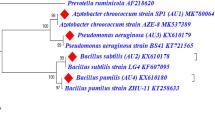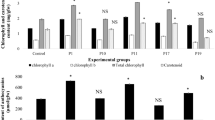Abstract
Plant growth-promoting rhizobacteria (PGPR) are known to influence plant growth by various direct or indirect mechanisms. A total of 216 phosphate-solubilizing bacterial isolates were isolated from different rice rhizospheric soil in Northern Thailand. These isolate were screened in vitro for their plant growth-promoting activities such as solubilization of inorganic phosphate, ammonia (NH3), catalase and cell wall-degrading enzyme activity. It was found that 100% solubilized inorganic phosphate, 77.77% produced NH3 and most of the isolates were positive for catalase. In addition, some strains also produced cell wall-degrading enzymes such as protease (7%), chitinase (1%), cellulase (3%) and β-glucanase (3%), as evidenced by phenotypic biochemical test and quantitative assay using spectrophotometry. The isolates could exhibit more than two or three plant growth-promoting (PGP) traits, which may promote plant growth directly or indirectly or synergistically. Part of this study focused on the effect of NaCl, temperature, and pH on a specific the bacterial isolate Acinetobacter CR 1.8. Strain CR 1.8 was able to grow on up to 25% NaCl, between 25 and 55°C, and at pH 5–9. Maximum solubilization of tricalcium phosphate and aluminium phosphate was obtained at neutral pH, and 37°C. Strain CR 1.8 had protease activity but no cellulase, β-glucanase and cellulase activities.

Similar content being viewed by others
Abbreviations
- c.f.u.:
-
Colony forming units
- g :
-
Centrifugal field
- A :
-
Absorbance (−log T)
- PGP:
-
Plant growth-promoting
References
Antoun H, Kloepper JW (2001) Plant growth-promoting rhizobacteria (PGPR). In: Brenner S, Miller JF (eds) Encyclopedia of genetics. Academic Press, New York, pp 1477–1480
Baldani JL, Reis VM, Baldani VLD, Dobereiner J (2000) A brief story of nitrogen fixation in sugarcane—reasons for success in Brazil. Funct Plant Biol 29:417–423. doi:10.1071/PP01083
Bashan Y, Holguin G (1997) Azospirillum–plant relationships: environmental and physiological advances (1990–1996). Can J Microbiol 43:103–121
Cappucino JC, Sherman N (1992) Microbiology: a laboratory manual. Benjamin/Cummings Publishing Company, New York, pp 125–179
Cattelan AJ, Hartel PG, Fuhrmann JJ (1999) Screening of plant growth-promoting rhizobacteria to promote early soybean growth. Soil Sci Soc Am J 63:1670–1680
Chen YP, Rekha PD, Arun AB, Shen FT (2005) Phosphate-solubilizing bacteria from subtropical soil and their tricalcium phosphate-solubilizing abilities. Appl Soil Ecol 34:33–41. doi:10.1016/j.apsoil.2005.12.002
Cisse L, Amar B (2000) The importance of phosphate fertilizer for increased crop production in developing countries. AFA 6th international annual conference, 31 January–2 February 2000, Cairo, Egypt
Farah A, Iqbal A, Khan MS (2006) Screening of free-living rhizospheric bacteria for their multiple plant growth-promoting activity. Microbiol Res 63:11–19
Fiske CH, Subbarow Y (1925) The colorimetric determination of phosphorus. J Biol Chem 66:375–400
Gargova S, Roshkova Z, Vancheva G (1997) Screening of fungi for phytase production. Biotechnol Tech 11:221–224. doi:10.1023/A:1018426119073
Hilda R, Fraga R (1999) Phosphate solubilizing bacteria and their role in plant growth promotion. Biotechnol Adv 17:319–359
Hira GS, Khera KL (2000) Water resource management in Punjab under rice-wheat production system. Punjab Agricultural University, Ludhiana, India Research Bull. No 2/2000
Holt JG, Krieng NR, Sneath PHA, Staley JT, Williams ST (1994) In: Bergey manual of determinative bacteriology, 9th edn. Williams and Wilkins Pub., MD, USA
Illmer P, Schinner F (1995) Solubilization of inorganic calcium phosphates-solubilization mechanisms. Soil Biol Biochem 27:257–263. doi:10.1016/0038-0717(94)00190-C
Illmer P, Barbato A, Schinner F (1995) Solubilization of hardly soluble AlPO4 with P-solubilizing microorganisms. Soil Biol Biochem 27:265–270. doi:10.1016/0038-0717(94)00205-F
Johri JK, Surange S, Nautiyal CS (1999) Occurrence of salt, pH and temperature-tolerant phosphate-solubilizing bacteria in alkali soils. Curr Microbiol 39:89–93. doi:10.1007/s002849900424
Kang SC, Ha CG, Lee TG, Maheshwari DK (2002) Solubilization of insoluble inorganic phosphates by a soil-inhabiting fungus Fomitopsis sp. PS 102. Curr Sci 82:439–441
Khan MMK, Bhuiyan M, Kabir SM, Oki Y, Adachi T (2006) Effect of selected treatments on the production of rice (Oryza sativa) in acid sulfate soils in a stimulation study. Jpn J Trop Agric 50:109–115
Mishra R (1968) Ecology workbook. Oxford & IBA, Calcutta
Nautiyal CS (1999) An efficient microbiological growth medium for screening phosphate-solubilizing microorganism. FEMS Microbiol Lett 29:221–229
Pradhan N, Sukla LB (2005) Solubilization of inorganic phosphates by fungi isolated from agriculture soil. Afr J Biotechnol 5:850–854
Raghothama KG (1999) Phosphate acquisition. Annu Rev Plant Biol 50:665–693. doi:10.1146/annurev.arplant.50.1.665
Rangarajan S, Saleena LM, Vasudevan P, Nair S (2003) Biological suppression of rice disease by Pseudomonas spp. under saline soil condition. Plant Soil 251:73–82. doi:10.1023/A:1022950811520
Rodriguez H, Fraga R (1999) Phosphate solubilizing bacteria and their role in plant growth promotion. Biotechnol Adv 285:260–263
Sahoo A, Agarwal N, Kamra DN, Chudhary LC, Pathak NN (1999) Influence of the level of molasses in de-oiled rice bran-based concentrate mixture on rumen fermentation pattern incrossbred cattle calves. Anim Feed Sci Technol 80:83–90. doi:10.1016/S0377-8401(99)00055-3
Shin W, Ryu J, Kim Y, Yang J, Madhaiyan M, Sa T (2006) Phosphate solubilization and growth promotion of maize (Zea mays L.) by the rhizosphere soil fungus Penicillium oxalicum. 18th world conference of soil science, 9–15 July, Philadelphia
Smibert RM, Krieg NR (1994) Phenotypic characterization. In: Method for general and molecular bacteriology. Am Soc Microbiol 34:607–654
Sokal RP, Rohlf FJ (1999) Biometry: the principle and practice of statistics in biological research, 3rd edn. Freeman and Co., New York, pp 1–887
Thakuria D, Talukdar NC, Goswami C, Hazarika S, Boro RC, Khan MR (2004) Characterization and screening of bacteria from rhizosphere of rice grown in acidic soils of Assam. Curr Sci 86:978–985
The Institute of Science, Technology Development in Thailand (2003) High quality organic fertilizer (in Thai). Ministry of Science and Technology, Bangkok
Trivedi P, Kumar B, Pandey A, Palni LMS (2003) Growth promotion of rice by phosphate-solubilizing bioinoculants in a Himalayan location Plant. Soil Sci 102:291–299
Varsha-Narsian J, Thakkar J, Patel HH (1994) Inorganic phosphate solubilization by some yeast. Indian J Microbiol 35:113–118
Vyas P, Rahi P, Chauhan A, Gulati A (2007) Phosphate solubilization potential and stress tolerance of Eupenicillium parvum from tea soil. Mycol Res 111:931–938. doi:10.1016/j.mycres.2007.06.003
Yasmin S, Rahman Bakar MA, Malik KA, Hafeez FY (2004) Isolation, characterization and beneficial effects of rice associated plant growth-promoting bacteria from Zanzibar soil. J Basic Microbiol 44:241–252. doi:10.1002/jobm.200310344
Acknowledgement
A grant from The Commission of Higher Education is greatly appreciated. We thank Dr. Peter Green, NCIMB, UK for helping edit the manuscript.
Author information
Authors and Affiliations
Corresponding author
Rights and permissions
About this article
Cite this article
Chaiharn, M., Lumyong, S. Phosphate solubilization potential and stress tolerance of rhizobacteria from rice soil in Northern Thailand. World J Microbiol Biotechnol 25, 305–314 (2009). https://doi.org/10.1007/s11274-008-9892-2
Received:
Accepted:
Published:
Issue Date:
DOI: https://doi.org/10.1007/s11274-008-9892-2




